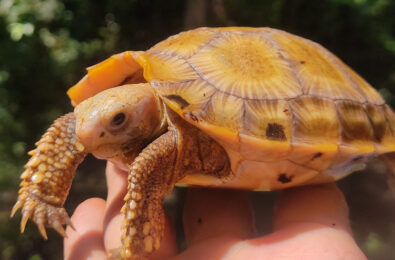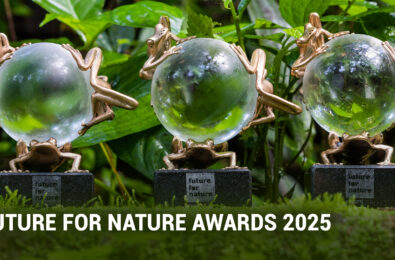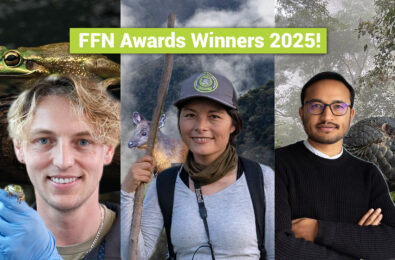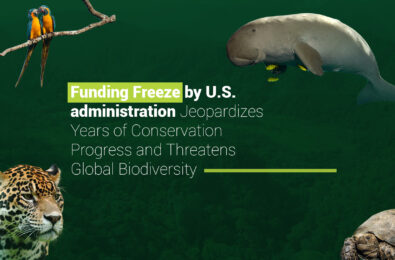A Look Back at the 2025 Future For Nature Awards
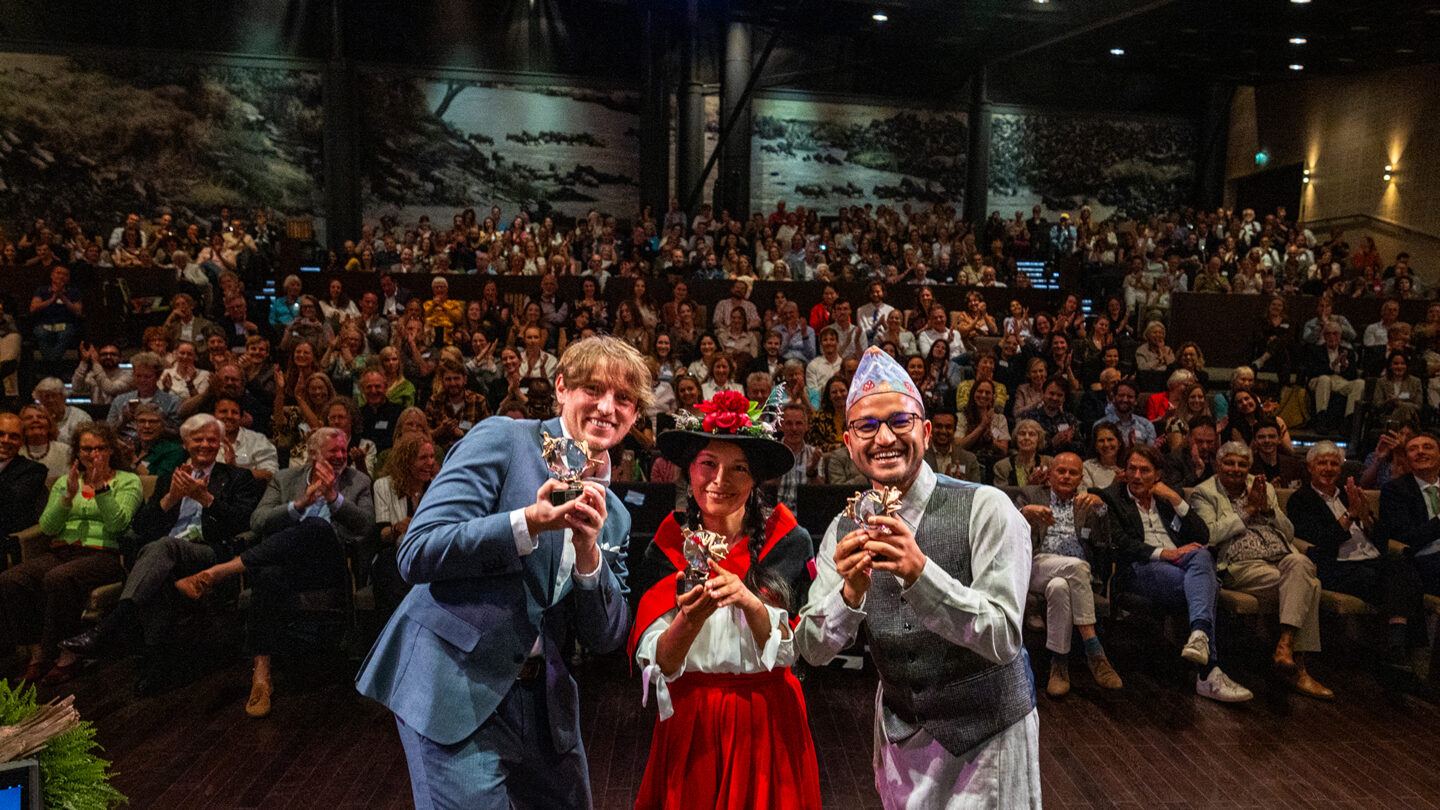
On Friday, May 16th, we celebrated the 18th Future For Nature Awards event. This year promising conservationists Ruthmery Pillco from Peru, Kumar Paudel from Nepal, and Anthony Waddle from Australia were honoured. The spotlight was on them, and their stories in yet another optimistic and hopeful ceremony, launching them into the Future For Nature Family.
A Network of Conservation Impact
Conservationist, BBC television presenter, filmmaker, and chair of the FFN International Selection Committee Saba Douglas-Hamilton hosted the show. In a touching speech talking about the collective consciousness of elephant populations across the African continent, and how we are only just beginning to understand their voices, emotions, and knowledge. AI will help us uncover an understanding of diversity that we can not yet imagine. And the question that we should ask ourselves is how do we treat these diverse voices that we can now hear?

“Now more than ever we need to reach out across the lines that divide us, and to stand together for the good that we believe in. For science, for facts, for truth, and for the glorious unity that we find in our diversity.” – Saba Douglas Hamilton, FFN Awards 2025.
During the Awards event we visited some of the FFN laureates virtually. We heard from Gabriel Massocato about the Giant Armadillo Project and the Armadillo Friendly honey in five different states of Brazil. From India we heard from Tiasa Adhya about the fishing cats in the Chilika lagoon with some beautiful camera trap footage. Adam Miller gave us an update about the lessons learned from 10 years of Planet Indonesia, about the local communities being the real stewards that carry the conservation mission forward.
Further in the ceremony Olivier Nsengimana showed us how a transformed trailer now serves as a mobile classroom – the Crane Cruiser – to reach remote communities and teach kids about nature. And Farwiza Farhan gave the audience a heartfelt message of motivation, and how we together can change things.

“Many people have asked me what threatens the Leuser ecosystem. When they ask they half expect a straightforward answer like palm oil, mining, or illegal logging. But in reality, the threat to the Leuser Ecosystem, is similar to the threat of any other landscape in the world. It is the belief that we need to exploit nature, to bring prosperity.” – Farwiza Farhan, FFN Awards 2025
An update from Mohsen Rezaie Atagholipour took us to the Persian gulf and the situation of the humpback dolphins there, caught in between the shores and the fishing nets. Mohsen is setting up consortia of nature conservation organisations to protect the remaining individuals. Els van Lavieren and Fernanda Abra showcased their FFN-funded collaborative project in which they implement the Reconnecta project in Suriname to monitor and prevent roadkill of reptiles and mammals. To conclude a milestone for Wietse van der Werf’s Sea Ranger Service was highlighted. They recently launched their new ship, which was baptized by Queen of the Netherlands Maxima. The new ship marks a huge expansion of the work of the Sea Ranger Service as a social enterprise.

Award winning Stories
The presentations by the winners this year were kicked off by Ruthmery Pillco from Peru. Ruthmery is a native Quechua and feels intrinsically connected with nature through her upbringing and her peoples believes. As a child her grandmother would tell her stories about the ‘ukuku’ – creatures half bear half human – that would go up the mountains and bring back ice to the village. The ice would be melted into ‘sacred water’ representing the connection between the cloud forest and the Amazon. Ruthmery was the first of her family to go to university. And she immediately felt like she belonged in the cloud forest when she first visited. She has been patiently studying the ecosystem and learned about its inhabitants. The Andean bear being the creature that caught her attention most, due to the parallels of its characteristics with her own personality. Recently another elusive species revealed itself to Ruthmery in camera trap footage: the Andean dwarf deer. This species unknown to science represents the fragility of the cloud forest that is being pushed down by agricultural expansion and fires from above, and being pushed up by climate change pushing cloud formation to higher elevations.

Kumar Paudel taught us about the pangolin trafficking going on in Nepal. A shocking 10 pangolins are being poached every hour. Growing up in a tiny village near the border with China, Kumar sometimes ate pangolin meat himself. It was just another sources of protein and the hunters liked it because they could also sell the scales to China. However, it is a crime with high sentences in Nepal. To understand why people still would engage in poaching, Kumar spent two years visiting prisons and talking to people convicted for wildlife crime. He slowly gained an understanding and developed ways to change it. People did not seem to be aware of the penalties. Even – they were not aware of the pangolin species. From one of the interviews, Kumar remembers the species being called the ‘forest fish’. This man couldn’t believe he was held captive for ‘just eating a fish’. With the help of his team at Greenhood Nepal Kumar now develops awareness raising materials to inform the communities and help protect the pangolin.

The final acceptance speech was delivered by Anthony Waddle from Australia. Where many amphibian experts have lost hope altogether in fighting the chytrid fungus threat that is wiping out amphibian species, Anthony is not out of ideas yet. He figured that if the fungus likes cold, and the frogs (being endothermic) like heat, this could be a simple and effective way to help individuals fight their infection. He developed ‘frog saunas’ to test this idea. Surprisingly the frogs that used the saunas not only cured their infection, they seemed to be immunized for future infections too! A major breakthrough in the amphibian crisis that has been going on for two decades now. While the frog saunas are being trialled, Anthony also works on other solutions such as the ‘frog spa’ where wild individuals are caught for a short time period and bathed in an anti-fungal solution. A more controversial approach involved gene editing. Some frog species in the world do not seem to be affected by Chytrid as much. Do they perhaps carry a specific gene? Could this gene be copy-pasted into the genome of struggling frog species, to save them from extinction? This radical approach is not without opposition. However, in the grim situation of many amphibian populations we need to look into brave and drastic measures to increase the toolbox of conservation and save species.

Guest of Honour Brigitte Baptiste
This year we were honoured with the presence of Brigitte Baptiste as the Guest of Honour. Brigitte Baptiste is a Colombian ecologist, academic, and one of Latin America’s most prominent voices in biodiversity conservation and environmental science. Brigitte is also a trailblazing public figure as one of the most visible transgender women in Colombia’s academic and environmental sectors. She actively promotes diversity, inclusion, and gender equity, seeing them as essential components of environmental and social resilience.
Her speech focused on a theme that is close to her heart and aligned well with the thoughts Saba Douglas Hamilton brought forward in her foreword of the event: what is our position regarding nature? Where do we speak from, when we speak for other species? It is a deeply reflective question, and one that should be asked more often in this time of tremendous technological changes such as AI.
Future For Nature announcements
After a celebratory round of applause, Future For Nature was ready to announce two wonderful new developments that were in preparation for over two years: the FFN podcast, and the FFN Academy children’s book! Both projects were inspired by the stories of the FFN winners and their species, and are aimed at bringing their inspiration closer to the homes of our audience.
Missed the Event or want to be re-inspired? Watch the ceremony via our YouTube channel:












